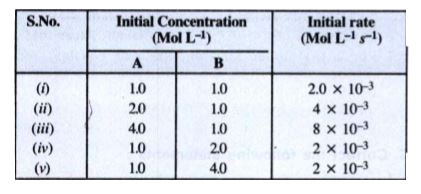For the reaction A+B→ Products, the following initial rates were obtained at various given initial concentrations.
 ltrbgt Write rate law and find the rate constant for the above reaction.
ltrbgt Write rate law and find the rate constant for the above reaction.
The rate law equation may be expressed as:
Rate = k[A]p[B]q ltrbgt Comparing experiments, 1 and 2,
(Rate)1=k[0.1]p[0.1]q=0.05
(Rate)2=k[0.2]p[0.1]q=0.10
Dividing eqn. (ii) by eqn. (i),
(Rate)2(Rate)1=k[0.2]p[0.1]qk[0.1]p[0.1]q=0.100.05=2:[2]p=[2]1 or p=1
Comparing experiments 1 and 3,
(Rate1)=k[0.1]p[0.1]q=0.05
(Rate)3=k[0.1]p[0.2]q=0.05
Dividing eqn. (iii) by eqn. (i),
Rate3Rate1=k[0.1]p[0.2]qk[0.1]p[0.1]q=0.050.05=1,[2]1=1=[2]0orq=0
Rate law for the reaction, rate = k[A]1[B]0
Rate constant (k) for the reaction may be calculated as follows:
k[0.1]p[0.1]q=0.05,k[0.1]1[0.1]0=0.05 , k=0.050.1=0.5
Topper's Solved these Questions
- CHEMICAL KINETICSBOOK - DINESH PUBLICATIONCHAPTER - CHEMICAL KINETICSEXERCISE - NCERT Exercise
1 Video
- CHEMICAL KINETICSBOOK - DINESH PUBLICATIONCHAPTER - CHEMICAL KINETICSEXERCISE - NCERT in text questions
38 Videos
- CHEMICAL BONDING AND MOLECULAR STRUCTUREBOOK - DINESH PUBLICATIONCHAPTER - CHEMICAL BONDING AND MOLECULAR STRUCTUREEXERCISE - Unit Test - 1
20 Videos
- CHEMICAL THERMODYNAMICS AND CHEMICAL ENERGETICS BOOK - DINESH PUBLICATIONCHAPTER - CHEMICAL THERMODYNAMICS AND CHEMICAL ENERGETICS EXERCISE - Exercise
507 Videos
Similar Questions
For the reaction A+ B rightarrowproduct , the folowing initial rates were obtained at various given initial concentrations:

Determine the half - life period.
View SolutionThe following initial rate data were obtained at 300K for the reactions:
2A+B→C+D

Deducethe rate law.
View SolutionFor the reaction A+B→C. The following data were obtained. In the first experiment, when the initial concentrations of both A and B are 0.1M, the observed initial rate of formation of C is 1×10−4mollitre−1minute−1. In the second experiment when the initial concentrations of A and B are 0.1M and 0.3M, the initial rate is 9.0×10−4molliter−1minute−1. In the third experiment when the initial concentrations of both A and B are 0.3M the initial rate is 2.7×10−3mollitre−1minute−1.
(a) Write rate law for this reaction.
(b) Calculate the value of specific rate constant for this reaction.
View SolutionFor the given reaction
A+B→ Products,
the following data are given.

(a) Write the rate equation.
(b) Calculate the rate constant.
View SolutionFor the given reaction
A+B→ Products,
the following data are given.

(a) Write the rate equation.
(b) Calculate the rate constant.
View SolutionFor the given reaction, A+B→ Products following data were obtained

(i) Write the rate law expression.
(ii) Find the rate constant.
View SolutionConsider the reaction, A+B→C+D.
The initial rate for different initial concentrations of the reactants are given below :

Write the rate law equation.
View SolutionConsider the reaction, A+B→C+D.
The initial rate for different initial concentrations of the reactants are given below :

Write the rate law equation.
View SolutionConsider the reaction, A+B→C+D.
The initial rate for different initial concentrations of the reactants are given below :

Write the rate law equation.
View SolutionFor the reaction A+B→C+D, the initial rate for different reactions and initial concentration of reactants are given below:

(i) What is the overall order of reaction ?
(ii) Write the rate law equation.
View Solution
